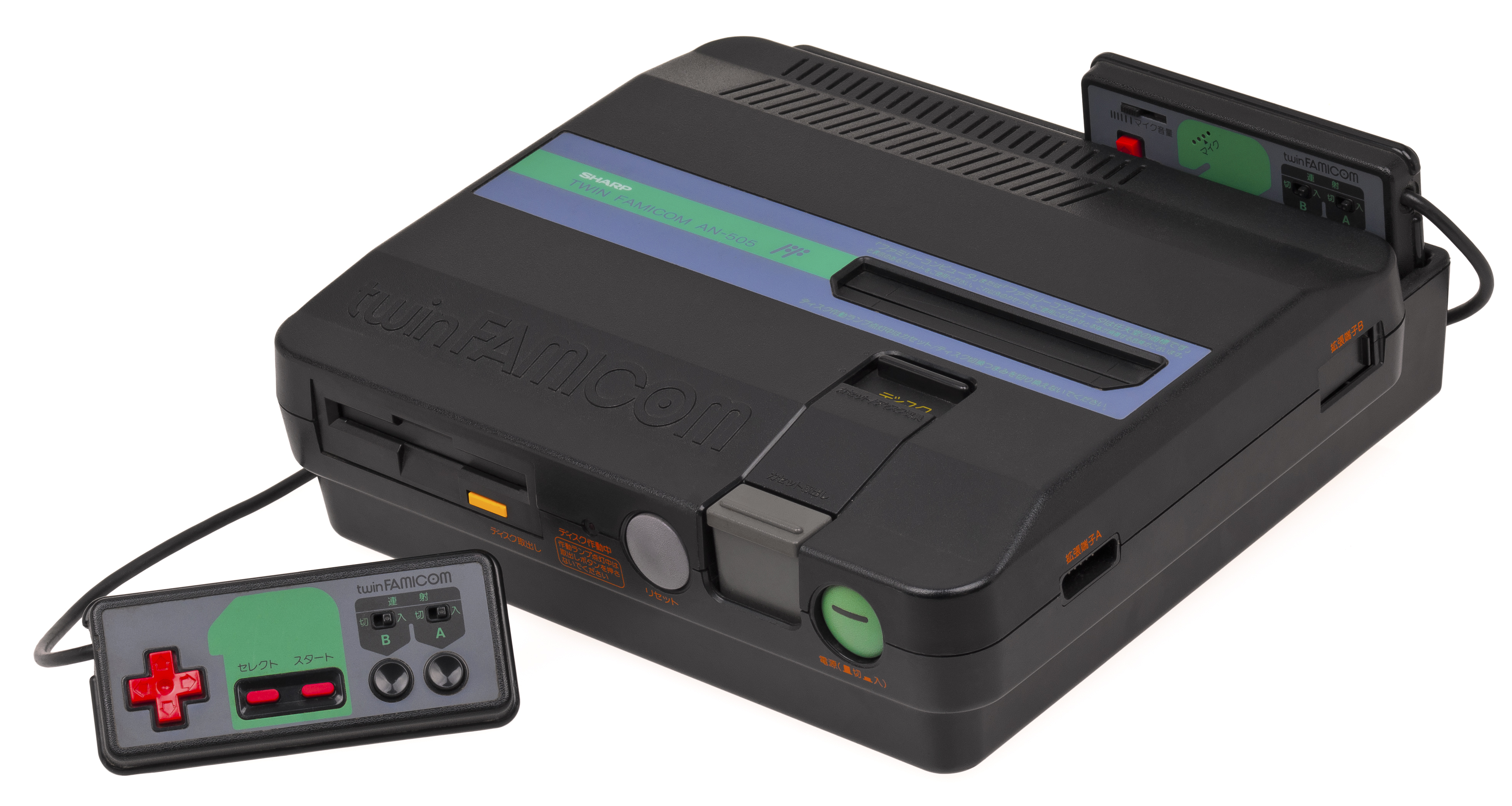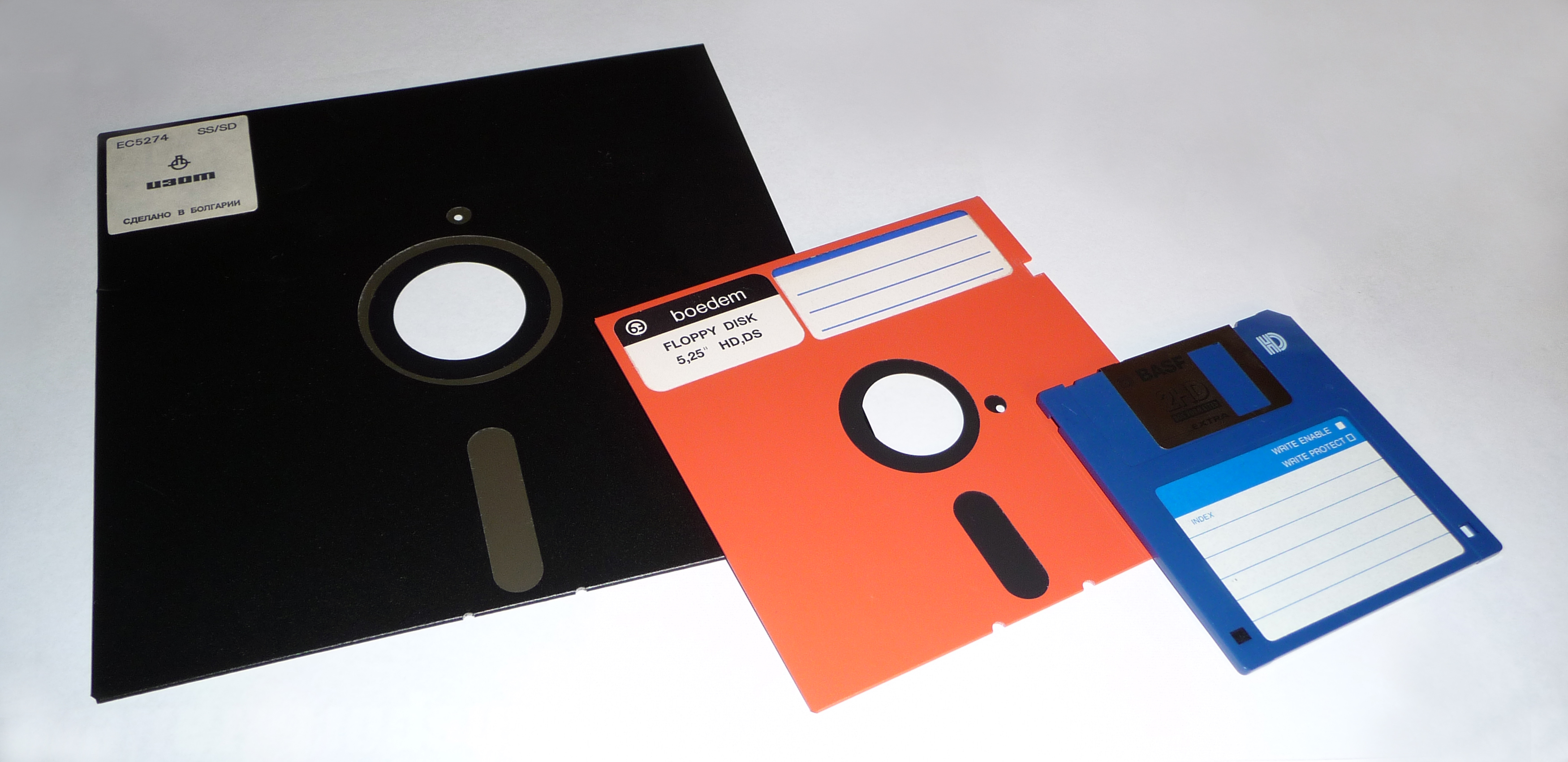 |
Famicom Disk System
The commonly shortened to the Famicom Disk System, is a peripheral for Nintendo's Family Computer (Famicom) home video game console, released in Japan on February 21, 1986. The system uses proprietary floppy disks called "Disk Cards" for more affordable data storage and adds a high-fidelity sound channel to enhance audio in compatible Disk System games. To support the Disk System, Nintendo installed "Disk Writer" kiosks in stores across Japan that allowed customers to bring their Disk Cards and have new games rewritten onto them for a small fee, making it a cost-effective alternative to purchasing games on traditional RAM cartridges. Nintendo also offered similar disk rewriting services by mail. The Disk System was designed to enhance features already present in the base Famicom, offering better sound and cheaper, rewritable games. However, it came with drawbacks, including a high initial price for the device along with the storage medium's slower load times and reduced relia ... [...More Info...] [...Related Items...] OR: [Wikipedia] [Google] [Baidu] [Amazon] |
 |
Nintendo
is a Japanese Multinational corporation, multinational video game company headquartered in Kyoto. It develops, publishes, and releases both video games and video game consoles. The history of Nintendo began when craftsman Fusajiro Yamauchi founded the company to produce handmade ''hanafuda'' playing cards. After venturing into various lines of business and becoming a public company, Nintendo began producing toys in the 1960s, and later video games. Nintendo developed its first arcade games in the 1970s, and distributed its first system, the Color TV-Game in 1977. The company became internationally dominant in the 1980s after the arcade release of ''Donkey Kong (1981 video game), Donkey Kong'' (1981) and the Nintendo Entertainment System, which launched outside of Japan alongside ''Super Mario Bros.'' in 1985. Since then, Nintendo has produced some of the most successful consoles in the video game industry, including the Game Boy (1989), the Super Nintendo Entertainment Syste ... [...More Info...] [...Related Items...] OR: [Wikipedia] [Google] [Baidu] [Amazon] |
|
Digital Distribution In Video Games
In the video game industry, digital distribution is the process of delivering video game content as digital information, without the exchange or purchase of new physical media such as ROM cartridges, magnetic storage, optical discs and flash memory cards. This process has existed since the early 1980s, but it was only with network advancements in bandwidth capabilities in the early 2000s that digital distribution became more prominent as a method of selling games. Currently, the process is dominated by online distribution over broadband Internet. To facilitate the sale of games, various video game publishers and console manufacturers have created their own platforms for digital distribution. These platforms provide centralized services to purchase and download digital content for either specific video game consoles or personal computers. Some platforms may also serve as digital rights management systems, limiting the use of purchased items to one account. Digital distribution ... [...More Info...] [...Related Items...] OR: [Wikipedia] [Google] [Baidu] [Amazon] |
|
|
Retro Gamer
''Retro Gamer'' is a British magazine, published worldwide, covering Retrogaming, retro video games. It was the first commercial magazine to be devoted entirely to the subject. Launched in January 2004 as a quarterly publication, ''Retro Gamer'' soon became a monthly. In 2005, a general decline in gaming and computer magazine readership led to the closure of its publishers, Live Publishing, and the rights to the magazine were later purchased by Imagine Publishing. It was taken over by Future plc on 21 October 2016, following Future's acquisition of Imagine Publishing. History The first 18 issues of the magazine came with a coverdisk. It usually contained freeware remakes of retro video games and emulators, but also videos and free commercial PC software such as ''The Games Factory'' and ''The Elder Scrolls: Arena''. Some issues had themed CDs containing the entire back catalogue of a publisher, such as Durell Software, Durell, Llamasoft and Gremlin Graphics. On 27 September 2005, ... [...More Info...] [...Related Items...] OR: [Wikipedia] [Google] [Baidu] [Amazon] |
|
|
Punch-Out!! (NES)
originally titled is a 1987 boxing video game developed and published by Nintendo for the Nintendo Entertainment System (NES). Part of the ''Punch-Out!!'' series, it is an adaptation of the arcade video games ''Punch-Out!! (arcade game), Punch-Out!!'' (1984) and ''Super Punch-Out!! (arcade game), Super Punch-Out!!'' (1984). Differences from the arcades include the addition of former Undisputed championship (boxing), undisputed world heavyweight champion Mike Tyson as the final boss. It received critical acclaim, and is retrospectively considered one of the List of video games considered the best, greatest video games of all time. Gameplay ''Punch-Out!!'' features Little Mac (Punch-Out!!), Little Mac, a young boxer fighting his way up through ranks of the World Video Boxing Association. After facing a series of colorful fictional opponents in three circuits and winning the championship in each, Little Mac enters a final "Dream Fight" against a highly skilled boxer. In the Gol ... [...More Info...] [...Related Items...] OR: [Wikipedia] [Google] [Baidu] [Amazon] |
|
 |
Family Computer Disk System Logo, Vector
Family (from ) is a group of people related either by consanguinity (by recognized birth) or affinity (by marriage or other relationship). It forms the basis for social order. Ideally, families offer predictability, structure, and safety as members mature and learn to participate in the community. Historically, most human societies use family as the primary purpose of attachment, nurturance, and socialization. Anthropologists classify most family organizations as matrifocal (a mother and her children), patrifocal (a father and his children), conjugal (a married couple with children, also called the nuclear family), avuncular (a man, his sister, and her children), or extended (in addition to parents, spouse and children, may include grandparents, aunts, uncles, or cousins). The field of genealogy aims to trace family lineages through history. The family is also an important economic unit studied in family economics. The word "families" can be used metaphorically to cr ... [...More Info...] [...Related Items...] OR: [Wikipedia] [Google] [Baidu] [Amazon] |
|
GameSpot
''GameSpot'' is an American video gaming website that provides news, reviews, previews, downloads, and other information on video games. The site was launched on May 1, 1996, created by Pete Deemer, Vince Broady, and Jon Epstein. In addition to the information produced by ''GameSpot'' staff, the site also allows users to write their own reviews, blogs, and post on the site's forums. It has been owned by Fandom, Inc. since October 2022. In 2004, ''GameSpot'' won "Best Gaming Website" as chosen by the viewers in Spike TV's second ''Video Game Award Show'', and has won Webby Awards several times. The domain ''GameSpot.com'' attracted at least 60 million visitors annually by October 2008 according to a Compete.com study. History In January 1996, Pete Deemer, Vince Broady, and Jon Epstein quit their positions at IDG and founded SpotMedia Communications. SpotMedia then launched ''GameSpot'' on May 1, 1996. Originally, ''GameSpot'' focused solely on personal computer games, so ... [...More Info...] [...Related Items...] OR: [Wikipedia] [Google] [Baidu] [Amazon] |
|
|
Nintendo Research & Development 2
commonly abbreviated as Nintendo R&D2, was a Japanese team within Nintendo that developed software and peripherals. While usually occupied in system operating software and technical support, the team would come back to early development in the 1990s where several new designers got their start at game development, the most famous being Eiji Aonuma who developed ''Marvelous: Another Treasure Island''. The team was formed as a spin-off of the older Nintendo Research & Development No. 1 Department and was initially led by Masayuki Uemura, who previously worked for Sharp Corporation. Using an idea of Sharp's solar technology, Uemura's department went on to develop the popular Nintendo beam gun games, selling over 1 million units. Kazuhiko Taniguchi took Uemura's position in 2004. Nintendo R&D2 was later merged into Nintendo Software Planning & Development, Nintendo SPD. History In the 1970s, Nintendo created the R&D2 department. In 2004, the department's general manager Masayuki U ... [...More Info...] [...Related Items...] OR: [Wikipedia] [Google] [Baidu] [Amazon] |
|
|
Masayuki Uemura
was a Japanese engineer, video game producer, and professor. He was known for his work as an employee of Nintendo from 1971 to 2004, most notably for serving as a key factor in the development of the Family Computer. A former employee of Sharp Corporation, Uemura joined Nintendo in 1971 working with Gunpei Yokoi and Genyo Takeda on solar cell technology for the Laser Clay Shooting System arcade game. After becoming General Manager of Nintendo R&D2, Uemura served as the lead architect for the Family Computer and Super Famicom video game consoles. He retired from Nintendo in 2004 and became director for the Center for Game Studies at Ritsumeikan University. Education Uemura graduated from the Chiba Institute of Technology with a degree in electronic engineering. He wrote in his autobiography that he very much enjoyed his learning years. Career Uemura originally worked at Sharp Corporation after graduating from college, selling solar cell batteries. He sold photocell techn ... [...More Info...] [...Related Items...] OR: [Wikipedia] [Google] [Baidu] [Amazon] |
|
 |
History Of The Floppy Disk
A floppy disk is a disk storage medium composed of a thin and flexible magnetic storage medium encased in a rectangular plastic carrier. It is read and written using a floppy disk drive (FDD). Floppy disks were an almost universal data format from the 1970s into the 1990s, used for primary data storage as well as for backup and data transfers between computers. In 1967, at an IBM facility in San Jose, California, work began on a drive that led to the world's first floppy disk and disk drive. It was introduced into the market in an format in 1971. The more conveniently sized 5¼-inch disks were introduced in 1976, and became almost universal on dedicated word processing systems and personal computers. This format was more slowly replaced by the 3½-inch format, first introduced in 1982. There was a significant period where both were popular. A number of other variant sizes were introduced over time, with limited market success. Floppy disks remained a popular medium for nearly ... [...More Info...] [...Related Items...] OR: [Wikipedia] [Google] [Baidu] [Amazon] |
|
Mitsumi
is a Japanese manufacturer of consumer electronic components, founded in 1954. Mitsumi has been a subsidiary of MinebeaMitsumi since 27 January 2017, when it merged with Minebea to form the parent company. Mitsumi is primarily known as an OEM manufacturer of computer peripherals and input devices, floppy and optical disc drives used in laptop computers, desktops, servers and the Famicom Disk System. Prior to its merger with Minebea, the company was listed on the Tokyo Stock Exchange, was a constituent of the Nikkei 225 stock index and provided its products through its subsidiaries in Asia, Europe, and North America. Products Video game console controllers One of the company's most noticeable product lines were video game console controllers. Mitsumi manufactured the official controllers for the following consoles: *Nintendo Entertainment System/Famicom controller *Super Nintendo Entertainment System/Super Famicom controller *GameCube controller (certain revisions only) an ... [...More Info...] [...Related Items...] OR: [Wikipedia] [Google] [Baidu] [Amazon] |
|
 |
Bee Card (game Cartridge)
A Bee Card (ビーカード, ''Bī Kādo'') is a ROM cartridge developed by Hudson Soft as a software distribution medium for MSX computers. Bee Cards are approximately the size of a credit card but thicker. Compared to most game cartridges, the Bee Card is small and compact. Bee Cards were released in Japan and Europe but not North America because the MSX was unsuccessful. However, Atari Corporation adopted the Bee Card for the Atari Portfolio, a handheld PC released in 1989 in North America. Some Korg Synthesizers and workstations also used Bee Cards as external storage of user content like sound programs or song data. Even though these systems all use Bee Cards, they are incompatible. Only a few MSX software titles were published on Bee Card: six in Japan and only two in Europe and Italy. To accept a Bee Card, the cartridge slot of the MSX had to be fitted with a removable adapter: the Hudson Soft BeePack. The first mass-produced Bee Cards, however, were EEPROM Telephone car ... [...More Info...] [...Related Items...] OR: [Wikipedia] [Google] [Baidu] [Amazon] |
|
Hudson Soft
was a Japanese video game company known for releasing numerous titles across video game consoles, home computers, and mobile phones. Headquartered in the Midtown Tower in Tokyo, it also maintained an office in the Hudson Building in Sapporo. Founded on May 18, 1973, Hudson initially focused on personal computer products before expanding into video game development, publishing, peripherals, and music production. The company was best known for its series ''Bomberman'', '' Adventure Island'', '' Star Soldier'', '' Bonk'' and '' Bloody Roar''. It also developed games for other publishers, most notably the ''Mario Party'' series for Nintendo. Hudson partnered with NEC to create the TurboGrafx-16, TurboExpress, and PC-FX consoles, aiming to compete with Nintendo, Sega, and SNK, while continuing to release games on other platforms as a third-party developer. Hudson Soft became a publicly traded company in 2000. In 2005, Konami acquired a 55% controlling stake in Hudson, later p ... [...More Info...] [...Related Items...] OR: [Wikipedia] [Google] [Baidu] [Amazon] |